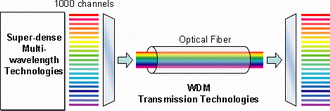First time 1,000 channel WDM transmission demonstration in an installed optical fiber

126 km-span transmission trial on the JGN II testbed
Nippon Telegraph and Telephone Corporation has successfully demonstrated 1,000 wavelength channel WDM (*1) transmission in an installed optical fiber for the first time in the world on the JGN II R&D testbed (*2) recently. The experiment utilized the 126 km test bed between Kyoto Keihanna and Osaka Dojima, transmitting 10 times more WDM channels with 8 times density (one 8th wavelength spacing) of the commercial systems.
Image: Super-dense 1,000 channel WDM transmission
NTT is proceeding to develop future photonic network technologies combining the most advanced WDM technologies and wavelength routing technologies in order to construct high-quality and flexible next-generation backbone networks. In the photonic networks, increasing the number of useable WDM channels is one of the most essential technical challenges for providing various attractive services for the customers. In the conventional commercial systems, however, the number of the WDM channels is limited to about 100 channels because the present systems need the same number of semiconductor laser diodes for transmitter as that of the WDM channels and it becomes difficult to control the wavelengths of the individual lasers.
NTT developed two breakthrough technologies used for the 1,000 channel WDM transmission, the super-dense multi-wavelength generation technologies and the super-dense WDM multiplexer/demultiplexer technologies. NTT develops a multi-wavelength lightwave source called supercontinuum (SC) (*3) lightwave source which can generate more than 1,000 high-quality wavelengths with a fixed frequency (wavelength) spacing. In the experiment, super-dense 1,000 wavelength channels were successfully generated by the SC source with a 6.25 GHz spacing, which is eight times more dense than that of the commercial systems. As a super-dense WDM multiplexer/demultiplexer, newly developed 6.25 GHz-spaced AWG (arrayed waveguide grating) filters were used to separate 1,000 individual wavelengths with low corsstalks. The demonstration was performed on 126 km JGN II R&D testbed networks between Keihanna Info-Communication Open Laboratory (*4) and Osaka Dojima where all the 1000 channels were successfully transmitted.
As demonstrated, the most-advanced technologies which are capable of processing precisely-controlled, more than 1,000 super-dense channels comprise NTT's fundamental core technologies to develop various new services in the future photonic IP networks. NTT continues to pursue research and development for future large-capacity photonic networks, fully utilizing the present new technologies and wavelength routing technologies.
Part of this research is supported by NICT's grant, "High-speed, wide-band, photonic access technology based on photonic networks". The present demonstration contribute to one of the technological research items, 1000 channel WDM technologies for e-Japan 2004 and will be presented at an International conference OFC/NFOEC 2005, which is being held in Anaheim, California, USA this week.
Glossary
*1 WDM
Wavelength Division Multiplexing. It is one of the multiplexing methods to transmit large --capacity information where the different channels are coded on different wavelengths and multiplexed at the transmitters and they are demultiplexed at the receivers.
*2 JGN II
JGN 2 is an open testbed network environment for research and development established in April, 2004 by the National Institute of Information and Communications Technology (NICT) as a new ultra-high-speed testbed networks for R&D collaboration between industry, academia, government. JGN2 provides nationwide IP network, optical wavelength networks, and research and development environment for optical testbed.
*3 Supercontinuum
Supercontinuum is defined as a phenomenon where the optical spectrum, thereby the number of wavelength broadens or increases explosively when an intense light transverse such transparent materials as glass. If the intense light composed of several wavelengths, such as optical pulses is used, the wavelengths interact to generate new wavelengths with a fixed frequency a pacing in a chain reaction fashion in an optical material.
*4 Keihanna Info-Communication Open Laboratory
Keihanna Info-Communication Open Laboratory was established by the National Institute of Information and Communications Technology in June, 2003 at the Keihanna Human Info-Communication Research Center of to promote IT research and development through collaboration between industry, academia and government, and to develop new technologies, human resources and new industries.
















